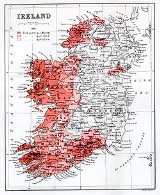
covers the period from the arrival of speakers of Celtic languages
in Ireland
to the present day.
The earliest known form of Irish, Primitive Irish, is found in Ogham
inscriptions dating from the 3rd or 4th century. After the conversion to Christianity
in the 5th century, Old Irish
begins to appear as gloss
es and other marginalia
in Latin
manuscripts, beginning in the 6th century. It evolved in the 10th century to Middle Irish.
Well, their poster child doesn't know it yet, but she's into me.
![]()
I guess I'll see you around...'same bat time' or whatever.![]()
[to Janet] Remember when you got drunk and nearly got the chancellor of Bulgaria killed? I covered for you!
![]()
[to Lucy] I'm here because I feel more like me when I'm with you, than I do when I'm with me.
![]()
I think love should be irresistible, like a drug, you know? I think when it happens you should just not be able to help yourself. I just - I wanted... more.
Dominique: You're not as boring as I thought. But you're not as bright, either.
![]()
Mr Phipps: You are a perfect liar.
![]()
Scud: Knock 'em dead... but not really.
![]()
Janet: Have you seen my gun?
![]()
They're crime-fighting hotties with killer bodies.
![]()

